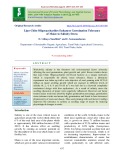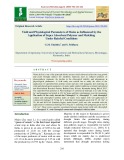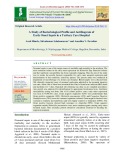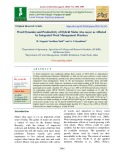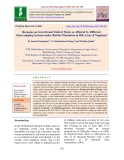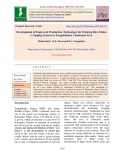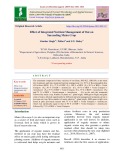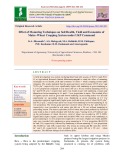
Yield of maize as affected
-
Maize is considered to be the third most important cereal after rice and wheat in India. It is being cultivated worldwide in a wider range of environmental conditions, because of its greater adaptability. It is known to be affected by more than 62 diseases. Among them, turcicum leaf blight caused by Exserohilum turcicum (Pass.) Leonard and Suggs is of significant importance as it drastically reduces the yield by reducing photosynthetic activity of the plant.
 8p
8p  chauchaungayxua11
chauchaungayxua11
 23-03-2021
23-03-2021
 18
18
 3
3
 Download
Download
-
Turcicum leaf blight (TLB) or Northern Corn Leaf Blight (NCLB) is a ubiquitous foliar disease of corn (maize) caused by Exserohilum turcicum, the anamorph of the ascomycete Setosphaeria. The TLB fungus survives through the winter on infected maize residue at the soil surface. As temperatures rise in the spring and early summer, the fungus produces spores on residue, and then the spores are splashed or wind-blown onto leaves of the new maize crop. Infection occurs during periods of moderate (64° to 81°F), wet and humid weather.
 7p
7p  chauchaungayxua6
chauchaungayxua6
 26-06-2020
26-06-2020
 17
17
 1
1
 Download
Download
-
Worldwide salinity is the foremost soil environmental factor adversely affecting the seed germination, plant growth and yield. Recent studies shows that Lipo Chito Oligosaccharide (LCO-nod factors) as a unique molecule, which is responsible for abiotic stress tolerance. Hence a laboratory experiment was taken up with a sole objective of seed priming with LCO (4 ml/kg) on maize seedling growth which are exposed to different levels of salinity (0, 2, 4, 6, 8 and 10 dS m-1 ) was laid out in a factorial completely randomized design with four replications.
 7p
7p  chauchaungayxua6
chauchaungayxua6
 26-06-2020
26-06-2020
 15
15
 0
0
 Download
Download
-
Zinc (Zn) is a micronutrient, which is involved in activating many physiological and biochemical processes. Inadequate supply of Zn affects crop growth, development and in turn yields. Most of us depend on agriculture based foods which are grown under inadequate Zn supply and hence we get less of Zn as recommended. A few strategic approaches are being adapted to overcome inadequacy of Zn in food. Biofortification is one of the best strategies to enhance the Zn content in the food grain.
 9p
9p  quenchua6
quenchua6
 15-06-2020
15-06-2020
 12
12
 1
1
 Download
Download
-
Water deficit is one of the principal abiotic stresses which adversely affect the crop growth and yield. Drought induces the metabolic functions such as reduced synthesis of photosynthetic pigments, the decline in the chlorophyll stability and alternations in physiological parameters.
 9p
9p  cothumenhmong5
cothumenhmong5
 17-05-2020
17-05-2020
 14
14
 1
1
 Download
Download
-
Low light is one of the most important environmental factors that determine the basic characteristics of rice growth and development. The selected twenty five adopted varieties are grown in Kharif 2016 under both normal and low light condition. The result were found that biochemical parameters such as grain starch content and total carbohydrate content (TCC) was decreased under low light condition and, nitrogen content in leaf was increased at flowering stage, protein content in grain was also affected by low light as well as grain yield and quality of rice.
 7p
7p  chauchaungayxua5
chauchaungayxua5
 08-05-2020
08-05-2020
 17
17
 1
1
 Download
Download
-
A field experiment was conducted during Rabi season of 2015-2016 at Agricultural College and Research Institute, Killikulam to find out the most effective weed control measure study weed dynamics, productivity and economics of hybrid maize as affected by integrated weed management. None of the pre-emergence herbicides alone provided desired control of weeds. However, inclusion of one hand weeding at 30 DAS with preemergence herbicides markedly improved weed control efficiency (WCE), yield attributes, grain and stover yield.
 6p
6p  quenchua4
quenchua4
 06-04-2020
06-04-2020
 11
11
 1
1
 Download
Download
-
A field experiment was conducted during the kharif season of the year 2017 and 2018 at the experimental farm of Krishi Vigyan Kendra, Mokokchung, Nagaland to assess the response on growth and yield of maize crop as affected by different intercropping system under rubber plantation. The experiment was laid out in “Randomised Block Design” with seven treatments and three replications. The treatments include sole maize, maize + frenchbean, maize + groundnut, maize + paddy, maize + ginger, maize + greengram and maize + turmeric.
 7p
7p  quenchua2
quenchua2
 18-12-2019
18-12-2019
 16
16
 0
0
 Download
Download
-
Traditional agricultural practices have resulted in decreased soil fertility, shortage of water resources and deterioration of agricultural ecological environment, which are seriously affecting production of maize. A field experiment was conducted in medium black soil during kharif and rabi season of 2016-17 and 2017-18 at farmer field near Agricultural Research Station, Sirguppa. The results revealed that, among improved production technologies of maize, higher grain yield were noticed with improved method-4 (T5: 7681 kg ha-1 ) over farmer method of cultivation (T1:5840 kg ha-1 ).
 8p
8p  cothumenhmong1
cothumenhmong1
 08-12-2019
08-12-2019
 10
10
 0
0
 Download
Download
-
The treatments comprised of three varieties of oat (Kent, JHO 822, JHO 851) as the main plot treatments and nine integrated nutrient management viz; 50 % of Recommended dose of Fertilizer (RDF) (F1), 75 % of RDF (F2), 100 % of RDF (F3), 50 % of RDF + Vermi Compost (F4), 50 % of RDF + Azotobactor (F5), 50 % of RDF + Vermi Compost + Azotobactor (F6), 75 % of RDF + Vermi Compost (F7), 75 % of RDF + Azotobactor (F8) and 75 % of RDF + Vermicompost + Azotobactor (F9) as the sub plot treatments followed by maize crop.
 4p
4p  cothumenhmong1
cothumenhmong1
 08-12-2019
08-12-2019
 14
14
 1
1
 Download
Download
-
A field investigation was carried out during kharif and rabi seasons of 2013-14 and 2014- 15 at Agricultural Research Station, Bheemarayanagudi to study the effect of manuring techniques on soil health, yield and economics of maize – wheat cropping system under irrigation. The results indicated that the grain and stover yield of maize (55.35 q ha-1 and 70.23 q ha-1 , respectively) were significantly higher with sunnhemp as green manuring in 1:2 row proportions compared to sole maize (60 cm x 20 cm) without manuring (43.85 q ha-1 and 50.
 11p
11p  nguaconbaynhay1
nguaconbaynhay1
 08-12-2019
08-12-2019
 17
17
 1
1
 Download
Download
-
As in many countries in Sub-Saharan Africa, the majority of poor smallholders in Malawi are left out of the agricultural extension and credit systems. These households, characterized by landholdings of less than 1 hectare and very low crop yields, are unable to grow enough food to feed themselves even though they focus much effort on producing food crops, especially maize.
 49p
49p  enterroi
enterroi
 01-02-2013
01-02-2013
 53
53
 6
6
 Download
Download
CHỦ ĐỀ BẠN MUỐN TÌM










